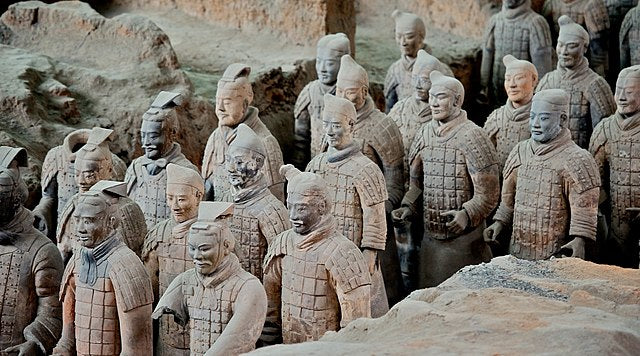
An Amazing Ancient Discovery: A Brief Guide to the Xi'an Terracotta Army
On March 29, 1974, the first pieces of what would be the world-famous Xi'an terracotta warriors were discovered. But how were they found, who found them, and what was this "ghost" army for? Find out in our brief guide to the unofficial eighth wonder of the world.
Farmers were the first to discover them
On March 29, 1974, a group of farmers outside Xi'an made an amazing discovery. Suffering a drought and desperate for water, Yang Zhifa, his five brothers, and their neighbor were digging for a well. That's when they discovered life-sized heads made of red clay as well as bronze arrowheads.
Another former farmer helped figure out what the findings were
Soon word reached farmer-turned-archaeologist Zhao Kangmin, who came to investigate. Eventually a vast terracotta army was unearthed. Zhao and his fellow archaeologists figured out that these soldiers, chariots, horses, and more were most likely constructed over two thousand years ago as part of an elaborate tomb for China's first emperor, Qin Shi Huang. Two thousand figures have been unearthed so far with an estimated 6,000 more to go.
Emperor Qin Shi Huang was obsessed with the afterlife

While Qin Shi Huang was an extremely accomplished emperor, he was also ruthless. Credited with unifying China, he did so by defeating six other kingdoms during the Warring States period.
He was the founder of the Qin dynasty, the first of imperial China, and responsible for making Chinese writing uniform so that "all words with the same meaning in the country’s varied languages would be represented by the same characters." However, he also suppressed dissent and encouraged citizens to inform on one another.
With enemies up the wazoo, he experienced several assassination attempts, which may have resulted in an obsession with living forever. Hence, the over-the-top tomb constructed for his afterlife. In addition to the army made to defend him, musicians, acrobats, and concubines were included to keep him entertained.
No two faces are alike
Despite the sheer number of warriors, each one has unique facial features. They're also divided into different ranks including archers, generals, charioteers, officers, and more, just like a real army at the time.
The figures were once painted with bright colors

[Photo: Charlie CC BY-SA 4.0]
It's believed the figures were originally painted in bright colors which indicated different ranks in the army. In the above photo are replicas of what they might have looked like.
The warriors sometimes go on tour

[Photo: Gremelm CC BY-SA 3.0]
Over the years China has lent out the warriors for exhibitions around the world. The first was the National Gallery of Victoria in Melbourne, Australia in 1982. Museums in the U.S. that have exhibited the soldiers include the Asian Art Museum in San Francisco, the National Geographic Society Museum in D.C., and the Metropolitan Museum of Art right here in NYC. Pictured is an exhibition at the Bowers Museum in Santa Ana, CA.
New warriors were found recently
Just this past January more than 20 new warriors were found, including a general and middle-ranking officer.
We unearthed our own terracotta warrior

We unearthed our own terracotta warrior replica in our warehouse last summer. You can see him and others on display in our SoHo store.

You can also excavate your own terracotta warriors with our fun kits.
Want to learn more about Asian cultures? Check out all our blog posts.
[Lead photo credit: Kevin McGill CC BY-SA 2.0]